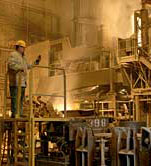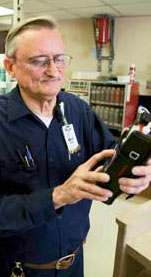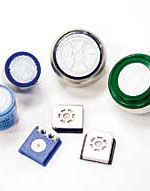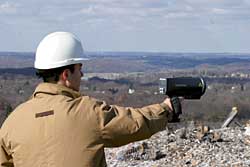
WHEN used independently of each other, the words industrial and hygiene could be construed as polar opposites. Industrial conjures up pictures of manufacturing plants, steel mills, production lines, and generally rough environments. Hygiene, on the other hand, is defined as a science of the establishment and maintenance of health.

ACCORDING to the National Human Activity Pattern Survey (NHAPS) as referenced by EPA, Americans spend about 90 percent or more of their time indoors. For this reason, the quality of our indoor air should be of great concern, whether it is in a home, a workplace, or a school, hospital, or medical facility--virtually any indoor environment. Poor indoor air quality can lead to a variety of health problems for any building occupant, especially at-risk populations (those younger than 2 or more than 70 years of age, immune system-compromised individuals, asthmatics, or those with severe allergies).

ADVANCEMENTS in safety gas detection sensor technology in the past few years have allowed dramatic reductions in the size and cost of personal multi-gas monitors, making it possible for employers to protect more workers against exposure to gas hazards in the workplace.
IF you have not heard of MRSA (methicillin resistant staphylococcus aureus) yet, you will very soon. MRSA (it is generally verbalized as mersa) used to be found only in hospitals.

COMPARED to, say, Uranus, the amount of methane on Earth isn't anything to phone home about. Then again, here on the Third Rock we do have human lives and safety to think about, and as we saw last year in mining disasters from West Virginia to eastern Kentucky and elsewhere, methane is among us in relative abundance, sometimes in deadly concentrations.
CONCRETE pours thick and cool, like a mud milkshake. On a hot day it may even seem inviting, as more than one homeowner has stepped in, shoeless, to level the surface of a driveway. So the idea that this seemingly harmless substance could be responsible for severe burns runs counter to common sense.
ACCEPTABLE IAQ in commercial buildings can often be achieved by maintaining air temperatures, relative humidities (RH), air movement, and background odors at levels that a large percentage of occupants (typically 80-90 percent) find satisfactory.
WITH the proliferation of lawsuits stemming from mold contamination, securing adequate insurance coverage for these types of claims can be a real challenge. As a result, the insurance manager is not always able to determine all of the risk management controls necessary to procure insurance coverage for this issue.
ACCORDING to the Environmental Protection Agency, Americans spend an average of 90 percent of their time indoors. Approximately 50 percent of that time is spent in the work environment. Experts estimate that nearly 30 percent of office buildings nationwide experience some form of indoor air quality (IAQ) problems. Employers, building managers, and building owners are faced with complaints, worker's compensation claims, and even lawsuits.
CARBON dioxide is the fourth most common gas present in the earth's atmosphere, with an average ambient concentration (in fresh air) of about 350 ppm. Carbon dioxide is one of the most common byproducts of living organisms. With every exhaled breath, we produce and release CO2 into the atmosphere (with an average concentration in exhaled breath of about 3.8 percent).
Imagine a world where everything in your home and workplace is automated to the point that you are never caught off guard with unforeseen, costly repairs. Imagine never having to call the emergency number for the electrician or pay exorbitant fees for a weekend visit from the refrigerator repairman.
N any work environment, employers need to consider environmental controls before ever putting an employee in personal protective equipment, such as a respirator, to protect them from dangerous contaminants. A fume extraction system should be one of the first steps to minimize employees' exposure of chemicals and particulates.
PICTURE the manufacturing industry as the process of constructing walls. Early manufacturing began by piling one large, irregular-shaped stone atop another, resulting in a wall that was sturdy because of its weight and size but demanding maximum space and materials and reaching only a fraction of its strength potential. As the industry progressed, these stones were shaped into blocks that fit one along another, increasing stability while reducing space and materials.
What is "duct cleaning"?
Ductwork sometimes can become both the source and the pathway for dirt, dust, and biological contaminants to spread through the building. In this case, duct cleaning usually means the removal of dirt, slime, mold, debris, and other materials found in ductwork and other HVAC components (e.g., cooling coil, drain pan).
IN the aftermath of Hurricane Katrina, mold has been receiving substantial press, and for good reason. Many health conditions have been attributed to mold exposure; as a result, there have been more than 10,000 mold-related lawsuits in the United States and the coining of the term "toxic mold."
HOSPITAL-acquired (nosocomial) infections are estimated to occur in nearly 10 percent of all acute care hospitalizations. The estimated incidence is more than 2 million cases per year, resulting in an added expenditure in excess of $4.5 billion. Transmission of both normal and pathological microorganisms by the hands of health care workers (HCWs) is one of the main routes of infection spread. Skin microorganisms may be considered resident flora or transient flora.
IT'S 2:30 in the afternoon and you are home in bed with a cold, sore throat, and runny nose, when the telephone rings. Your wife answers, then brings the phone to you. "It's your boss. There's a problem at work," she says.
WHAT are portable air cleaners (PACs) and how are they used? Portable air cleaners (PACs) are small hand transportable air cleaning units used in occupied spaces (classrooms, offices) to reduce the concentration of airborne particles and sometimes vapors and gases. They typically weigh 10-20 lbs, are freestanding, use local electrical current, and can be placed anywhere in a room.
MANKIND has continuously searched for and found evolving means for survival. Gas monitoring instrumentation has been a part of that evolution. In the span of the last 200+ years, the act of monitoring a worker's environment for explosive and toxic gases, as well as for oxygen enrichment or deficiency, has seen a tremendous evolution.
Editor's note: The ranks of safety and health consultants have exploded in recent years. Patricia Carlisle, CIH, who has been certified in the comprehensive practice of industrial hygiene by the American Board of Industrial Hygiene since 1990 and has been a private consultant for about 20 years, discussed competition, networking, and other consulting challenges in an April 21, 2005, conversation with Occupational Health & Safety's editor.